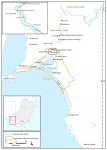(Press-News.org) It's not uncommon for crescent-shaped swaths of sand to dot the shorelines of meandering rivers. These swaths usually appear along the inner side of a river bend, where the bank wraps around the sandy patch, forming deposits known as a "point bars."
When they appear along an outer bank, which curves the opposite way, they form "counter-point" bars, which are usually interpreted by geoscientists as an anomaly: a sign that something - such as a patch of erosion-resistant rocks - is interfering with the river's usual manner of sediment deposition.
But according to research led by The University of Texas at Austin, counter-point bars are not the oddities they're often made out to be. In fact, they're a perfectly normal part of the meandering process.
"You don't need a resistant substrate, you can get beautiful [counter-point] bars without it," said Zoltán Sylvester, a research scientist at UT's Bureau of Economic Geology who led the study.
The finding suggests that counter-point bars - and the unique geology and ecology associated with them - are more common than previously thought. Building awareness around that fact can help geoscientists be on the lookout for counter-point bars in geological formations deposited by rivers in the past, and understand how they may be influencing the flow of hydrocarbons and water passing though them.
The research was published in the Geological Society of America Bulletin on March 12.
The co-authors are David Mohrig, a professor at the UT Jackson School of Geosciences; Paul Durkin, a professor at the University of Manitoba; and Stephen Hubbard, a professor at the University of Calgary.
Rivers are constantly on the move. For meandering rivers, this means carving out new paths and reactivating old ones as they snake across a landscape over time.
The researchers observed this behavior in both an idealized computer model and in nature, using satellite photos of a stretch of Bolivia's Mamoré River, which is known for quickly changing its path. The satellite photos captured how the river changed over 32 years, from 1986 - 2018.
In both the model and the Mamoré, counter-point bars appeared. The researchers found that the appearance was linked directly to short, high curvature bends: little spikes in a river's path.
The researchers observed that these spikes frequently form when the river's course is abruptly changed, such as when a new oxbow lake forms through cutoff, or after reconnecting with an old oxbow lake.
But the sharp bends don't stay put, they start migrating in the downstream direction. And as they rapidly move downstream, they create the conditions for sediment to accumulate around the bend as a counter-point bar.
The study shows a number of instances of this happening in the Mamoré. For example, in 2010, a sharp bend (bend 2 in the image) forms when an ox-bow lake reconnects with a downstream portion of the river. By 2018, the bend has moved about 1.5 miles downstream, with counter-point deposits along the shoreline marking its path.
Geomorphologists and engineers knew for some time that long-term change along a river can be described in terms of local and upstream values of curvature (places where the river seems to wrap around a small circle have high curvatures). In the study, the researchers used a formula that uses these curvature values to determine the likelihood of a counter-point bar forming at a particular location.
Sylvester said that he was surprised at how well this formula - and the simplified models used in part to derive it - worked to explain what was thought to be a complex phenomenon.
"Natural rivers, they are actually not that far from what these really simple models predict," Sylvester said.
This is not the first time that Sylvester's research has revealed that river behavior can be governed by relatively simple rules. In 2019, he led a study published in Geology that described a direct relationship between bend sharpness and river migration.
Superficially, point bars and counter-point bars look quite similar and frequently blend into one another. But counter-point bars are distinct environments: compared to point bars, they have finer sediments and lower topography, making them more prone to flooding and hosting lakes. These characteristics create unique ecological niches along rivers. But they are also geologically important, with ancient counter-point bar deposits preserved underground influencing the flow of fluids, such as water and oil and gas.
Mathieu Lapôtre, a geoscientist and assistant professor at Stanford University, said that recognizing that counter-point bars can readily form in meandering rivers - and having a formula for predicting where they will form - is a significant advancement.
"Altogether, the results of Sylvester et al. have important implications for a range of scientific and engineering questions," he said.
INFORMATION:
The research was funded by the bureau's Quantitative Clastics Laboratory research consortium.
PHILADELPHIA (March 16, 20201) - After a traumatic injury, returning to work (RTW) can be a strong indication of healing and rehabilitation and may play a pivotal role in promoting physical and functional recovery. But how does RTW after a traumatic injury affect mental health recovery, particularly in individuals who experience social and economic marginalization?
In a new study from the University of Pennsylvania School of Nursing (Penn Nursing), researchers investigated the ways that RTW after an injury predict mental health outcomes in Black men living and recovering in Philadelphia. The study found that men ...
AI has, for some time, been applied to diagnose medical conditions in specific fields. It can build on knowledge of particular disciplines to hone in on details such as the shape of a tumor that suggests breast cancer or abnormal cells that indicate cervical cancer. While AI is very good when trained on years of human data in specific domains, it has not been able to deal with the huge number of diagnostic tests (about 5000) and disorders (about 14,000) of modern clinical practice. Now, a new algorithm developed by engineers at the USC Viterbi School of Engineering can think and learn just like a doctor but with essentially infinite experience.
The work comes out of the lab of Gerald Loeb, a professor ...
BOSTON - In addition to lowering risk of heart disease, maintaining a heart-healthy lifestyle may pay off in lower risk for developing cancer, researchers from Massachusetts General Hospital (MGH) and other centers in the United States and the Netherlands have found.
Looking at the potential link between cardiovascular disease (CVD) and cancer among participants in two large population-based health studies, Emily S. Lau, MD, and Jennifer E. Ho, MD, from the division of Cardiology at MGH and their co-authors found that traditional risk factors for CVD, including older age, male ...
The discovery of a rare bone artefact near the Lower Murray River casts more light on the rich archaeological record on Ngarrindjeri country in southern Australia.
Details of the Murrawong bone point, dated between c. 5,300-3,800 years old, has have been described by Flinders University, Griffith University and other experts in a new paper in Australian Archaeology.
Probably made from a macropod (kangaroo or wallaby) bone, the point was likely used for piercing soft materials - for example, used as a pin on a cloak made of possum furs - or possibly as a projectile point, say the research leaders ...
Vision impairment is a pervasive problem facing nearly 2.2 billion people globally, according to the World Health Organization. But help is on the way: Neuroscientists are working at the cutting edge of technology and brain science to develop new ways for the vision impaired to navigate the world around them. At the annual meeting of the Cognitive Neuroscience Society (CNS), researchers are presenting new techniques for integrating digital haptics and sound technology to transform vision rehabilitation for both children and adults alike.
"Vision rehabilitation requires bridging fundamental research, modelling and neuroimaging methods," ...
FAIRFAX, Va. (March 16, 2021)--Many women suffering significant postpartum bleeding continue to receive hysterectomies, rather than uterine artery embolization (UAE), despite evidence that UAE results in reduced hospital stays and costs, and offers an opportunity to preserve fertility, according to new research to be presented at the Society of Interventional Radiology Annual Scientific Meeting.
"Giving birth has become increasingly dangerous for women in the U.S., and postpartum hemorrhage is a leading cause of the loss of life related to childbirth," said Janice M. Newsome, MD, FSIR, associate professor, Department of Radiology and Imaging ...
FAIRFAX, Va. (March 16, 2021)-- A minimally invasive treatment for patients whose cancer has spread to their bones provides quick and sustained pain relief and improves quality of life, according to a new study to be presented at the Society of Interventional Radiology Annual Scientific Meeting. The palliative treatment known as radiofrequency ablation (RFA) is effective in providing relief in as little as three days, and the benefits last more than 12 months--a significant improvement over radiation treatment.
"Commonly used radiation treatments can take weeks to provide pain relief," said Jason R. Levy, MD, a vascular and interventional radiologist at Northside Hospital in Atlanta and ...
FAIRFAX, Va. (March 16, 2021)-- A non-surgical treatment for arthritis in the knee is safe and effective in providing immediate and long-term pain relief, according to a new study to be presented at the Society of Interventional Radiology Annual Scientific Meeting. Genicular artery embolization (GAE) reduces inflammation in the knee to improve function and quality of life for people with moderate to severe knee pain. Osteoarthritis is one of most common causes of disability, limiting daily activities of 40% of all U.S. adults.
"Prior to treatment, patients' knee pain had taken over their whole life," said Siddharth A. Padia, MD, FSIR, professor of radiology, UCLA Health, and lead researcher of the study. ...
In an analysis that explores the structural underpinnings of a SARS-CoV-2 strain, G614, that quickly became dominant early in the pandemic, researchers discovered interactions that prevent this strain's spike from shedding its host binding domain too early. This may explain the enhanced infectivity of the G614 virus, they say. Throughout the COVID-19 pandemic, epidemiologists have monitored evolution of the SARS-CoV-2 virus with particular focus on the spike (S) protein. Spike trimers decorate the viral surface and facilitate host cell entry. An early variant with a single-residue substitution ...
March 16, 2021, PORT ST. LUCIE, FL: Researchers from Cleveland Clinic's Florida Research and Innovation Center (FRIC) have identified a potential new target for anti-COVID-19 therapies. Their findings were published in Nature Microbiology.
Led by FRIC scientific director Michaela Gack, Ph.D., the team discovered that a coronavirus enzyme called PLpro (papain-like protease) blocks the body's immune response to the infection. More research is necessary, but the findings suggest that therapeutics that inhibit the enzyme may help treat COVID-19.
"SARS-CoV-2 - the virus that causes COVID-19 - has evolved quickly against many of the body's well-known ...


